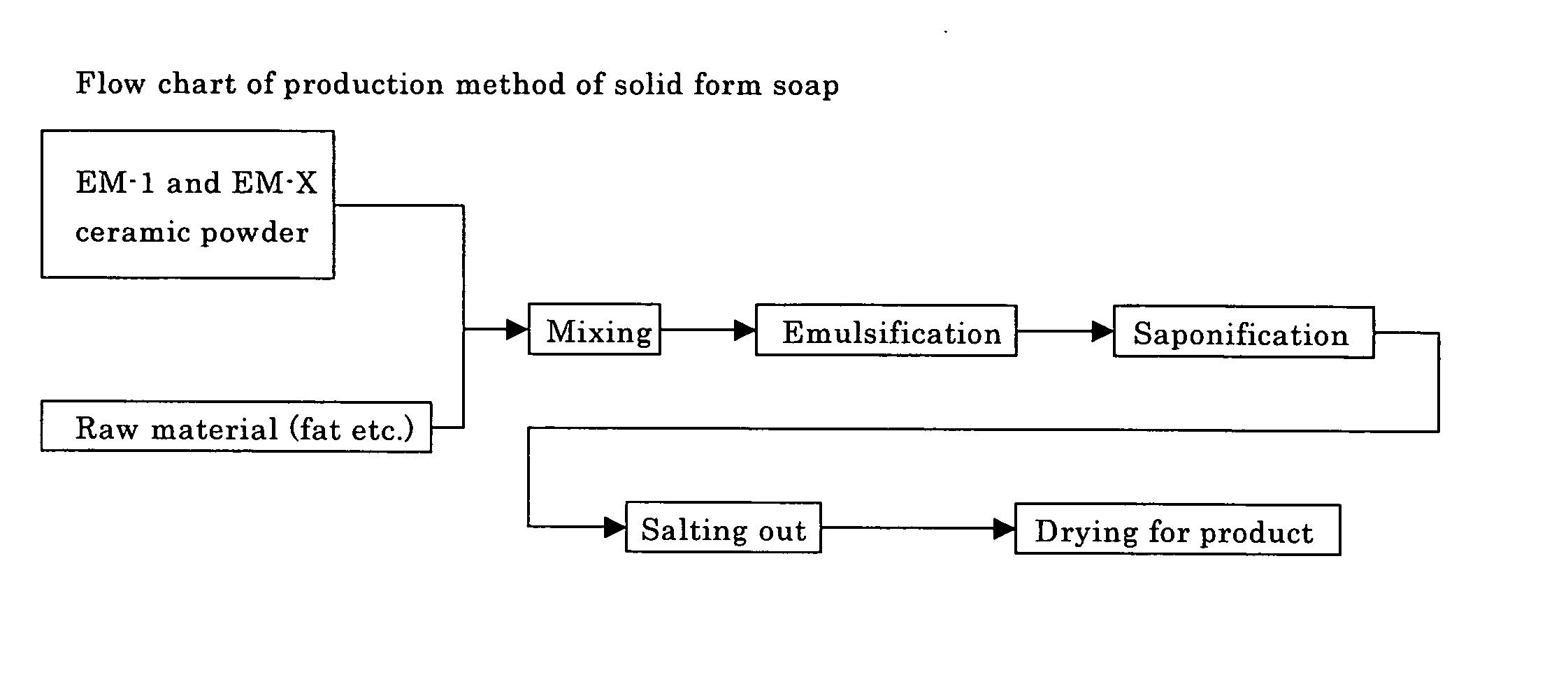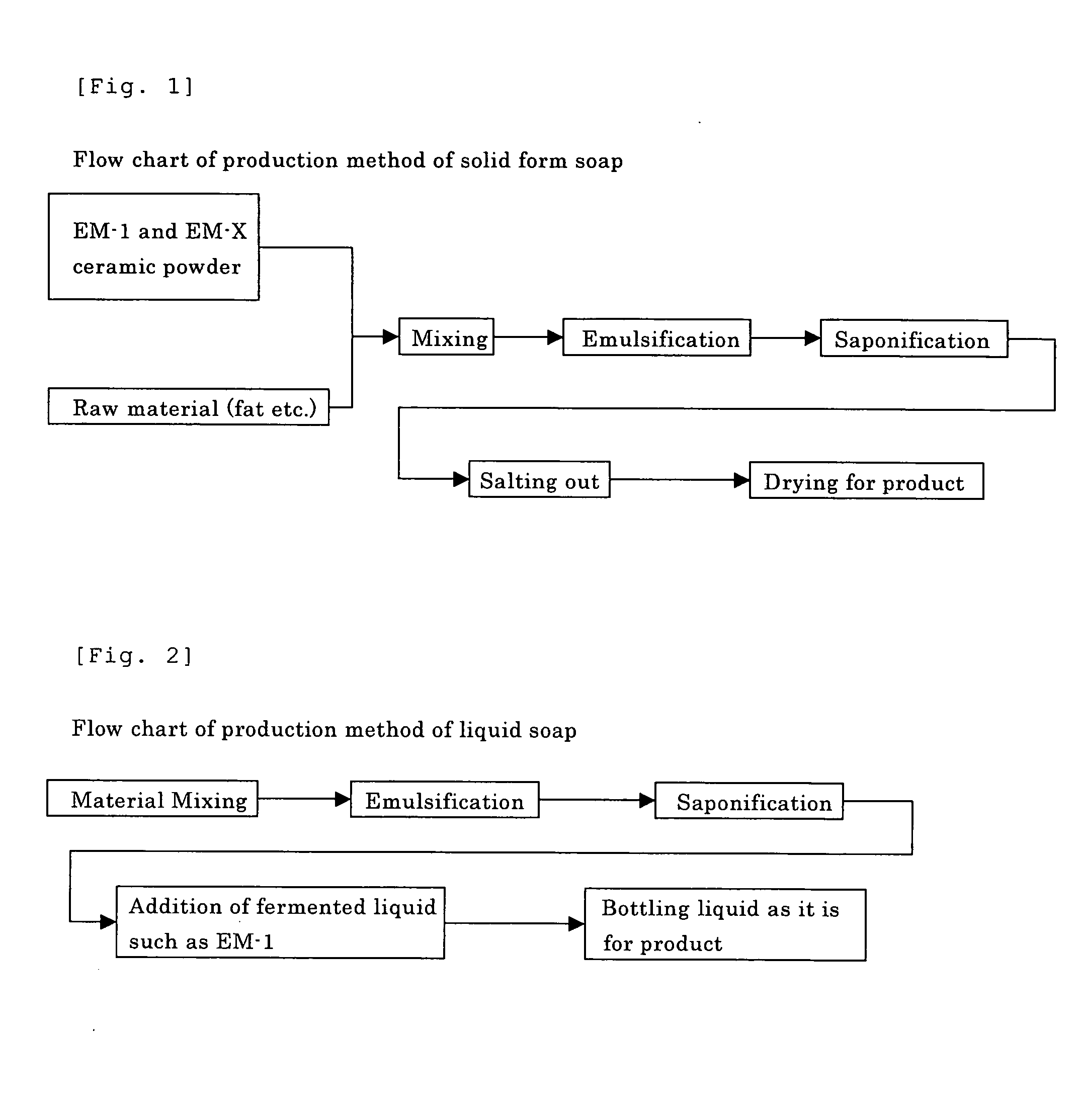Detergent made use of fermentation technology and production method thereof
a fermentation technology and detergent technology, applied in the field of soap, can solve the problems of reducing the treatment capacity, causing the adverse effect of the ecological system, and reducing the activation capacity of benign microorganisms, and achieves the effects of suppressing the proliferation of various bacteria, and reducing the number of toxic substances
- Summary
- Abstract
- Description
- Claims
- Application Information
AI Technical Summary
Benefits of technology
Problems solved by technology
Method used
Image
Examples
example 1
[0025]FIG. 1 is one example of flow chart of solid form soap production method, in a pre-stage prior to an emulsification process, EM or a fermented material with EM, and EM-X ceramic powder are added.
[0026] In this case, although the microorganisms added cannot be counted from soap as a viable cell, after using detergent, effective components contained therein become a nutrient for benign indigenous microorganisms present in environment, so that organic carbons in soap are rapidly decomposed.
[0027] A most simple production method is a method that EM-1 is added as a raw material, alternatively, a material fermented with EM can be used. An example of the fermented materials is aqueous fermented molasses or rice rinsed water. Also, extracts of various organics and various minerals can be directly added, but, before addition, fermentation by EM can afford the same effect as the addition of EM-1. Through the above processes, various fermentation substances can be added, and additives ...
example 2
[0030]FIG. 2 is one example of liquid soap production method. After saponification, EM-1 or a secondary culture liquid of EM-1, or a fermented rice rinsed water, which is a high nutrition liquid can be added to produce a liquid soap. A treatment prior to saponification follows Example 1.
[0031] Table 2 is a table that the number of microorganisms contained in finished soap was counted. As shown in Table 2, when microorganisms are added after saponification, viable cell count is possible.
TABLE 2Number of microorganisms in soapLactic acidSortYeastbacteriaOrdinary soapNot detectedNot detectedEM added soap10 × 10415 × 104
example 3
[0032] Further, there are methods such as a direct fermentation method of raw materials and a method providing fat with antioxidant power by adding a fermented material to fat. Specifically, as described in Japanese Unexamined Patent Publication 2002-128683, a material that rice bran is fermented by EM is used. However, in Japanese Unexamined Patent Publication 2002-128683, aerobic microorganisms are used and utilized as an aqueous solution, but a primary object of the present invention is that hydrophobic antioxidant substances being present more than water-soluble antioxidant substances in a fermented product are integrated into fat. When raw materials are directly fermented, EM-1 will be used, on this occasion, acceleration of fermentation can be done by conducting monosaccharides like glucose as a substrate. Also, even without addition of substrate, by adding EM-1 or fermented substances generated in accordance with it, and setting an aging period of about 45-90 days, the fermen...
PUM
 Login to View More
Login to View More Abstract
Description
Claims
Application Information
 Login to View More
Login to View More - R&D
- Intellectual Property
- Life Sciences
- Materials
- Tech Scout
- Unparalleled Data Quality
- Higher Quality Content
- 60% Fewer Hallucinations
Browse by: Latest US Patents, China's latest patents, Technical Efficacy Thesaurus, Application Domain, Technology Topic, Popular Technical Reports.
© 2025 PatSnap. All rights reserved.Legal|Privacy policy|Modern Slavery Act Transparency Statement|Sitemap|About US| Contact US: help@patsnap.com


